Red wine braised lamb shanks sounds like a fancy recipe, but it's really easy. I'll show you how to make lamb shanks three different ways so they turn out perfectly every time, whether they're braised in the oven, in the slow cooker, or on the stovetop, using just a few simple ingredients!
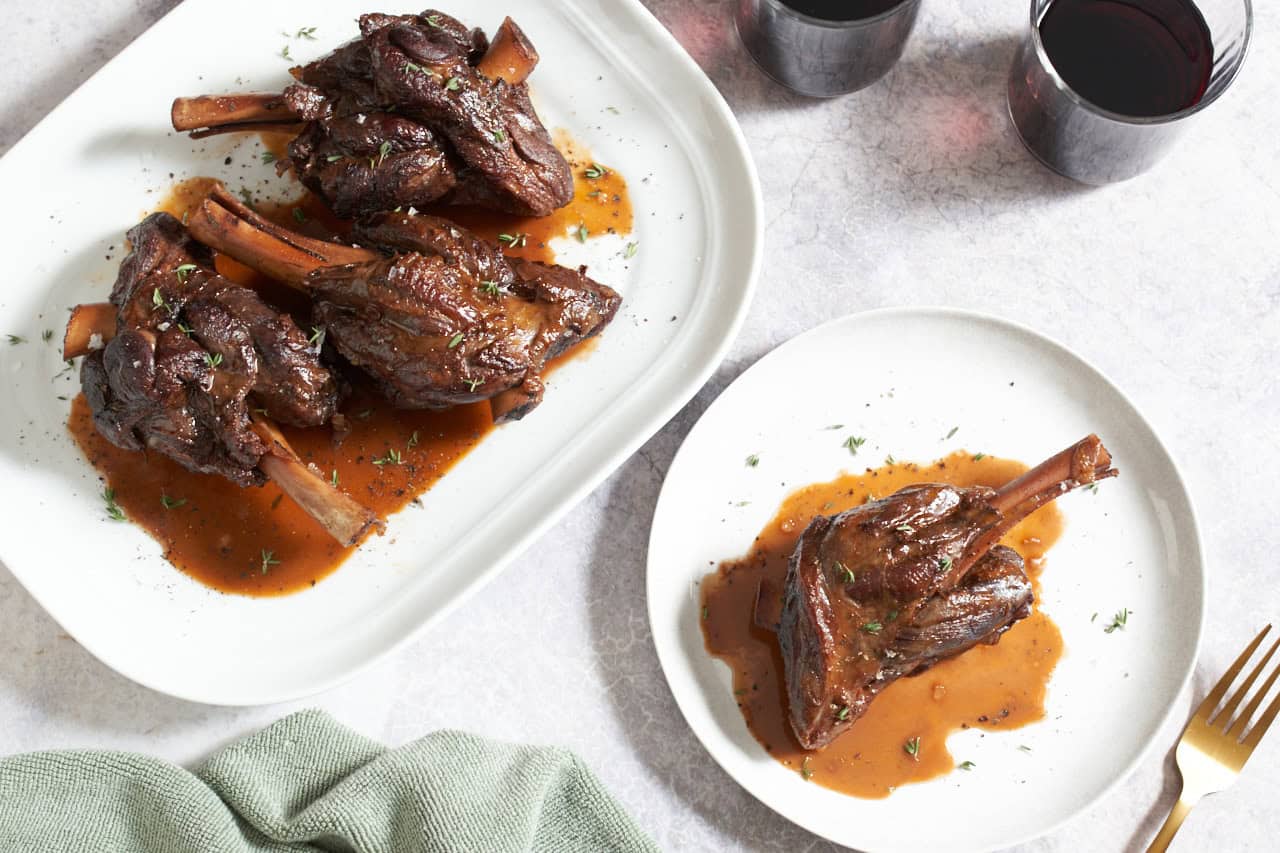
Braising is one of the easiest, most no-fuss cooking techniques ever. All you have to do is partially submerge meat in a tasty liquid and cook it low and slow until it's fall-off-the-bone tender.
You can make braised lamb shanks with red wine sauce in the oven, on the stovetop, or in the slow cooker. All three cooking methods are very similar, and I'll give you instructions for each one so you can choose your own adventure!
The punch of red wine vinegar in the sauce adds a light, bright hit of acidity, and that's what makes my recipe so special!
My husband loves it when I make these for a romantic dinner, and they're ideal for a holiday celebration, too. If you like this idea, you'll love my Red Wine Braised Short Ribs.
Jump to:
- Red wine braised lamb shanks ingredients
- How to make braised lamb shanks in red wine (oven instructions)
- Stovetop instructions
- Slow cooker instructions
- Expert tips
- Storage and reheating
- What to serve with red wine lamb shanks
- More lamb recipes
- Braised lamb shanks in red wine is a simple recipe with a lot of flavor!
- Recipe
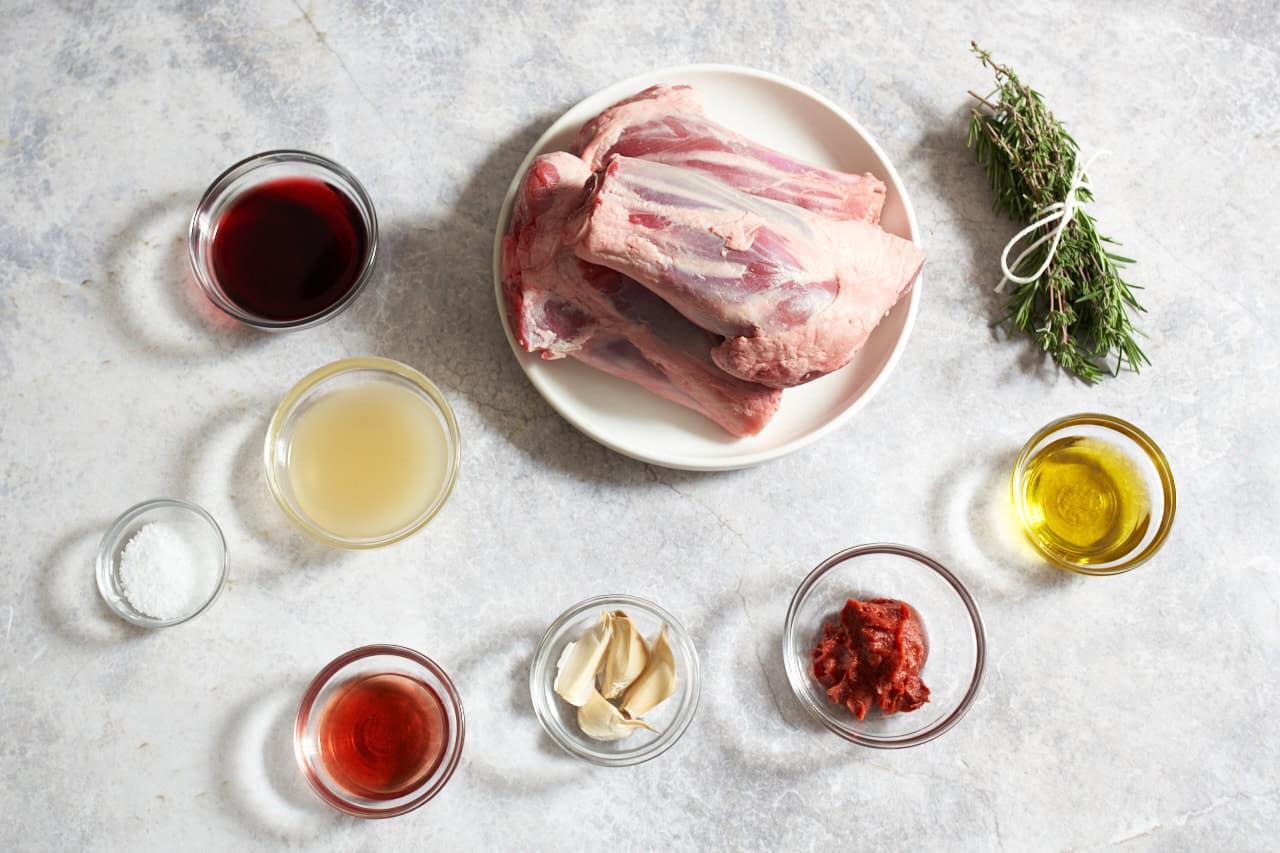
Red wine braised lamb shanks ingredients
- Lamb shanks: In case you were curious, the lamb shank is the lower part of the leg, just above the knee joint. It's a muscle that works hard and has a lot of connective tissue which makes it tough, so lamb shanks need to be cooked low and slow like pulled pork to tenderize the meat. That's why braising is such a great cooking method for this cut.
- Red wine: The wine is there to add acidity, so you don't want anything too heavy or sweet. Remember when cooking with wine, it doesn't have to be expensive, but it does need to taste good, so always use a wine that you would drink! Choose a light-bodied, dry red wine. I like to use Chianti or Sangiovese when I make my red wine pasta recipe, either of those would work well for braised lamb shanks, or try a Spanish wine like Tempranillo or Rioja.
- Garlic, onion, fresh thyme, fresh rosemary: These aromatics will flavor the cooking liquid and infuse the lamb as it cooks.
- Tomato paste: To add sweetness and balance, and it will thicken the sauce.
- Red wine vinegar: This is my secret to the best tasting sauce! We'll add red wine vinegar during the braise, and again after the sauce has reduced. It adds a light, bright note and keeps the flavor of the lamb from being too heavy or overwhelming.
- Chicken broth: I prefer chicken broth over beef broth or vegetable broth, because it doesn't add any flavors that compete with the lamb shanks or the red wine. You could also substitute water.
* Ingredient measurements are listed in the recipe card at the bottom of the post.
How to make braised lamb shanks in red wine (oven instructions)
I prefer oven braised lamb shanks because it requires the least amount of babysitting, makes for the silkiest sauce, and yields exquisitely tender meat. No matter the cooking method you've chosen for this lamb shank recipe, all of the steps are very similar.
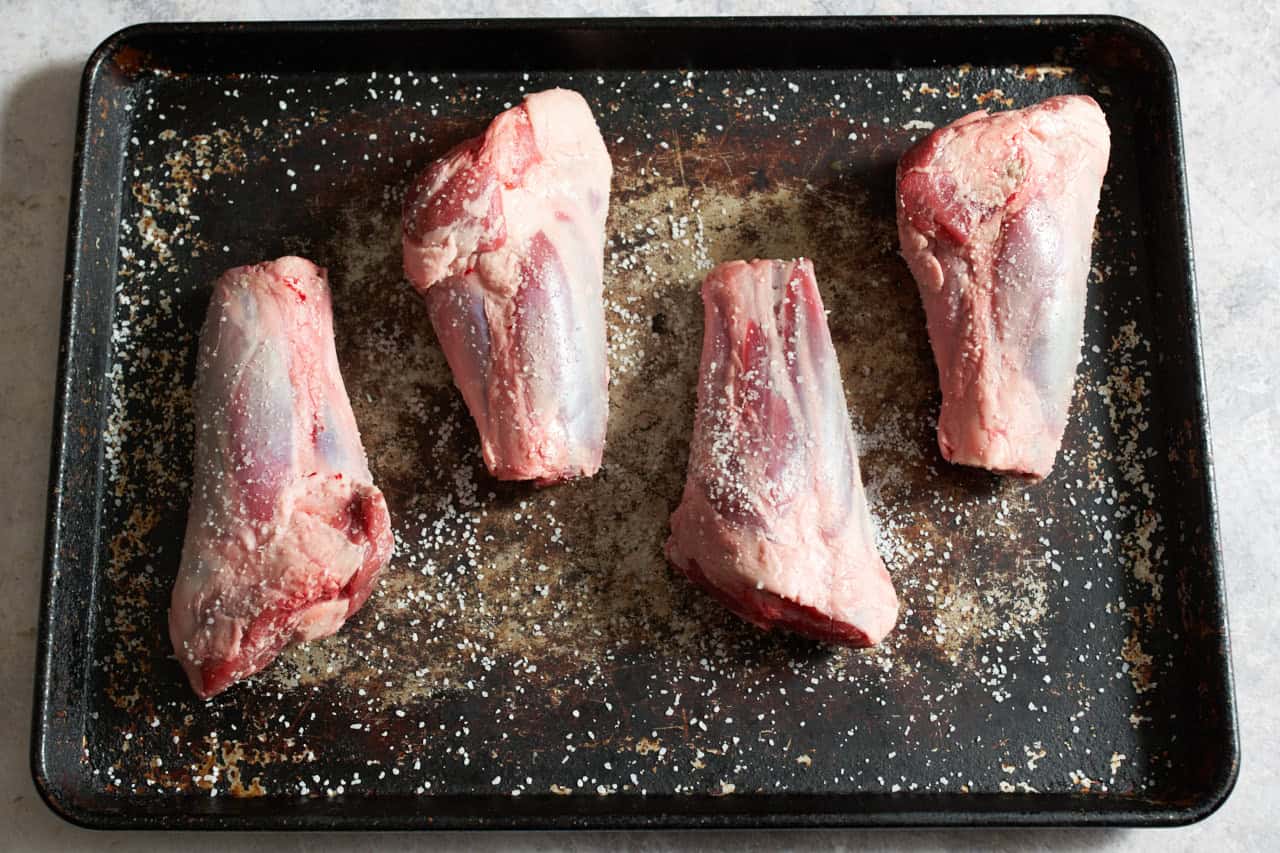
Step 1: Sear the lamb shanks
If you're braising in the oven, preheat it to 350 degrees F. Place the lamb shanks on a sheet pan and season generously with salt and freshly ground black pepper.
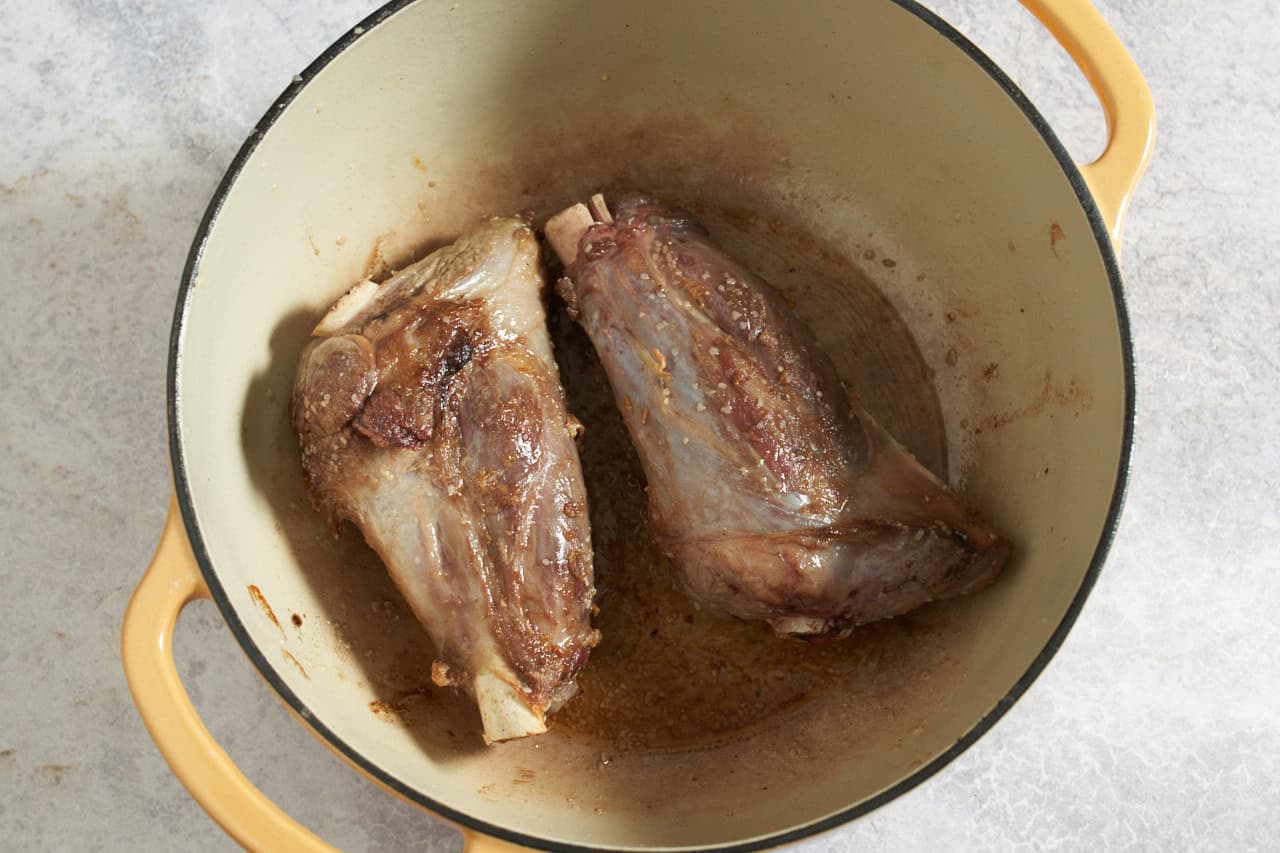
Place a large Dutch oven over medium high heat and add 1 tablespoon of extra virgin olive oil. Working in 2 batches, sear the lamb shanks on all sides until a golden-brown crust begins to form, then set aside on a plate.
You'll probably have to use some long-handled tongs to hold them on their sides, or prop them up on the side of the pan to get all the edges browned.
Disclosure: I'm a member of the Lodge blogger network. The Dutch oven shown was gifted to me. All opinions are my own.
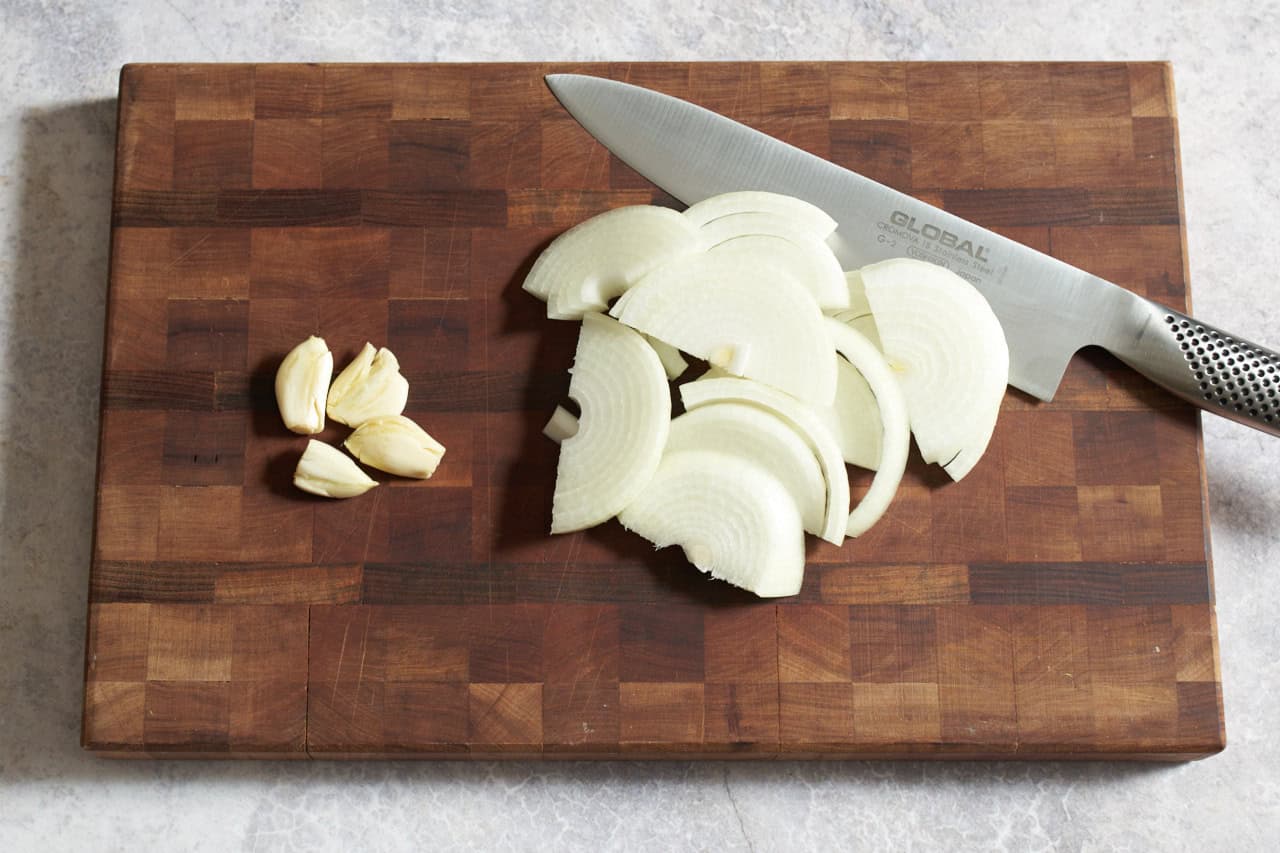
Step 2: Cook the aromatics
While the lamb sears, tie the sprigs of thyme and rosemary together in a bundle with kitchen twine. Peel the garlic cloves and use the side of a good chef's knife to smash them, then set aside. Cut the onion into thick slices.
Prep tip
The onions and garlic are going to be strained out of the red wine sauce before serving, so there's no need to spend a lot of time chopping, slicing or dicing them. Smashing the garlic will ensure it releases all of that flavor, and just make sure you cut the onions about the same size so they cook evenly.
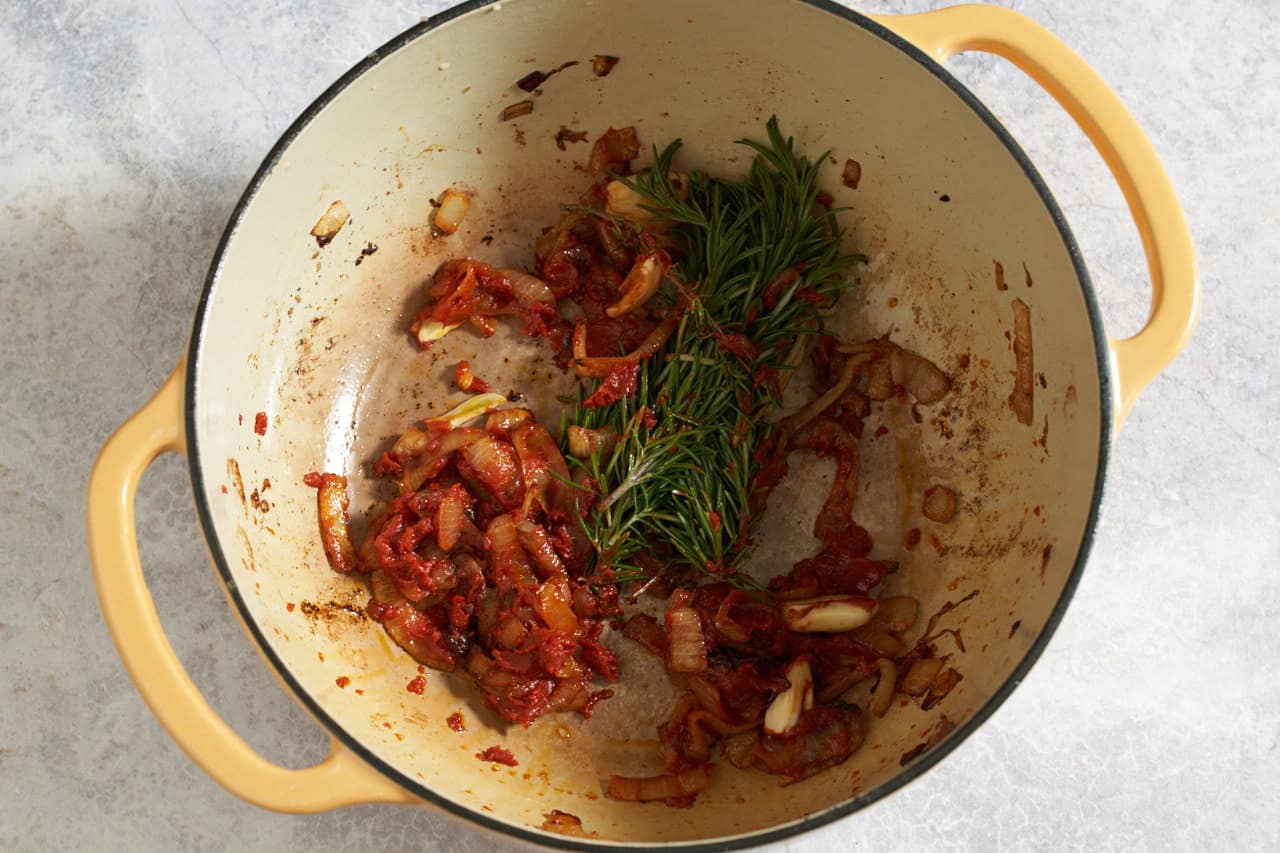
After the lamb has been seared, reduce the heat to medium and add the remaining olive oil and sliced onions to the Dutch oven. Cook the onions until tender and translucent, about 5-8 minutes. Season with a pinch of kosher salt.
Add the smashed garlic cloves and the bundle of herbs to the pan and stir for 1-2 minutes until fragrant. Then add the tomato paste, stirring and pressing it into the other ingredients for 1 minute.
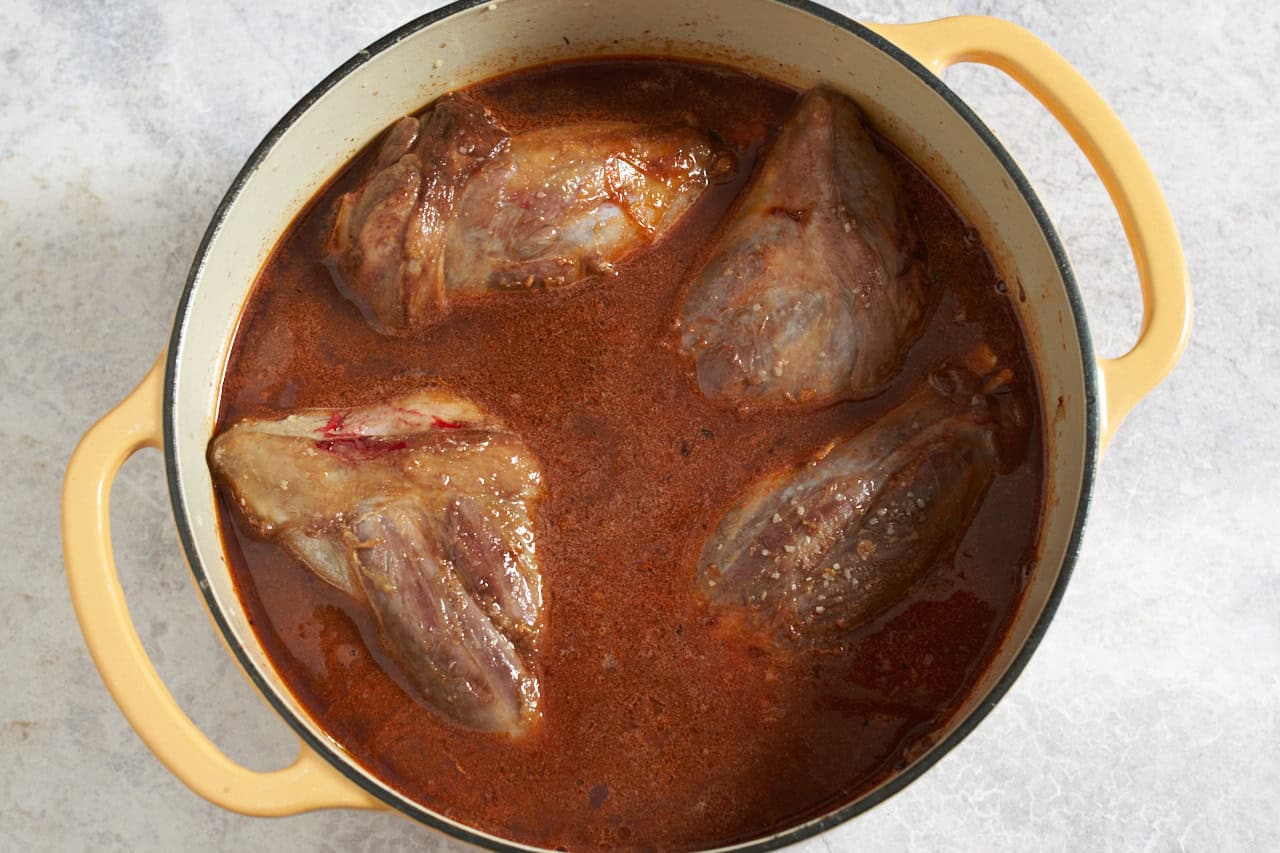
Want to save this recipe?
You'll join hundreds of readers on my email list!
Step 3: Add red wine and stock
Add the red wine to the pot to deglaze it, use a wooden spoon or spatula to scrape up any bits on the bottom of the pan, then add the chicken stock. Return the lamb shanks and any resting juices to the Dutch oven, making sure some of the meat is still above the surface of the liquid, (see tips below) cover with the lid.
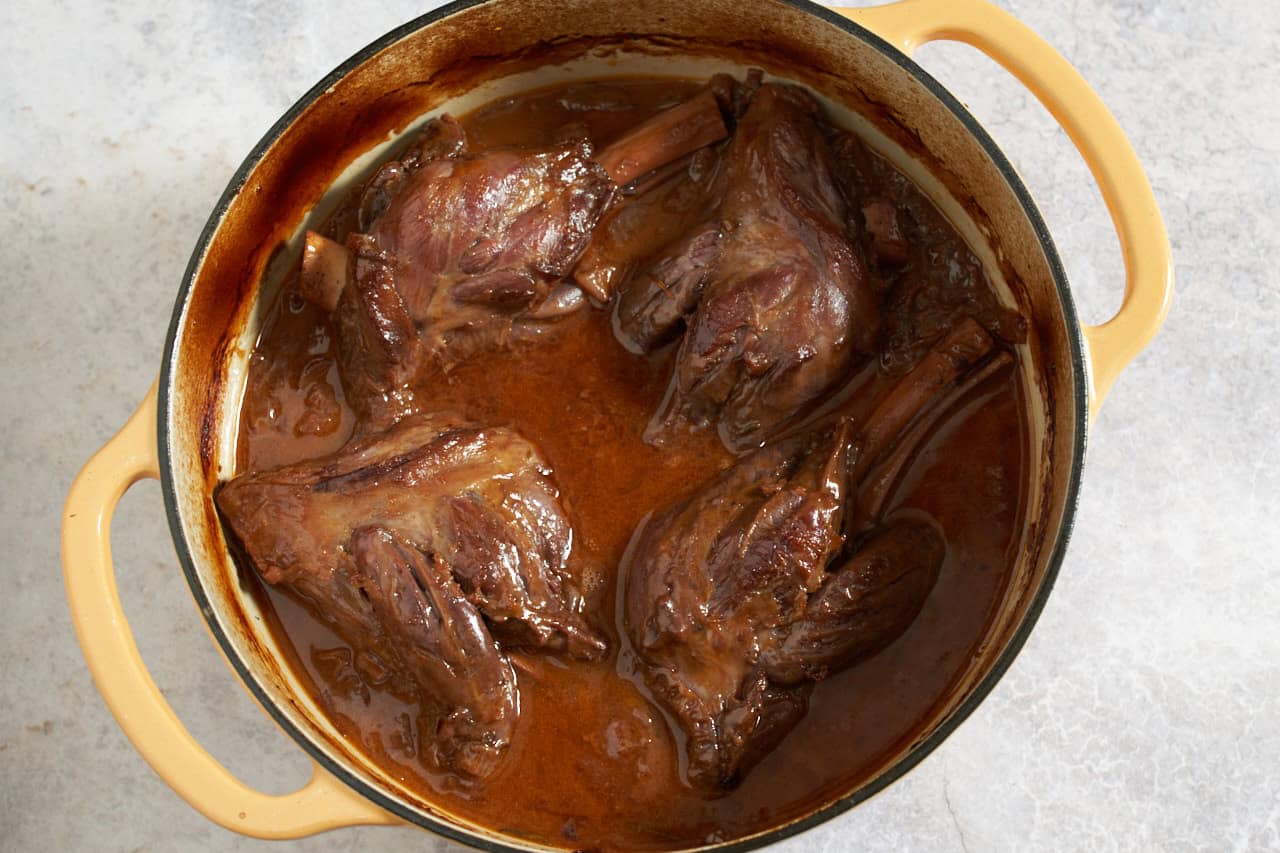
Step 4: Braise the lamb shanks
Transfer the lamb shanks to the oven and braise for 2-2 ½ hours, until they are tender and falling off the bone.
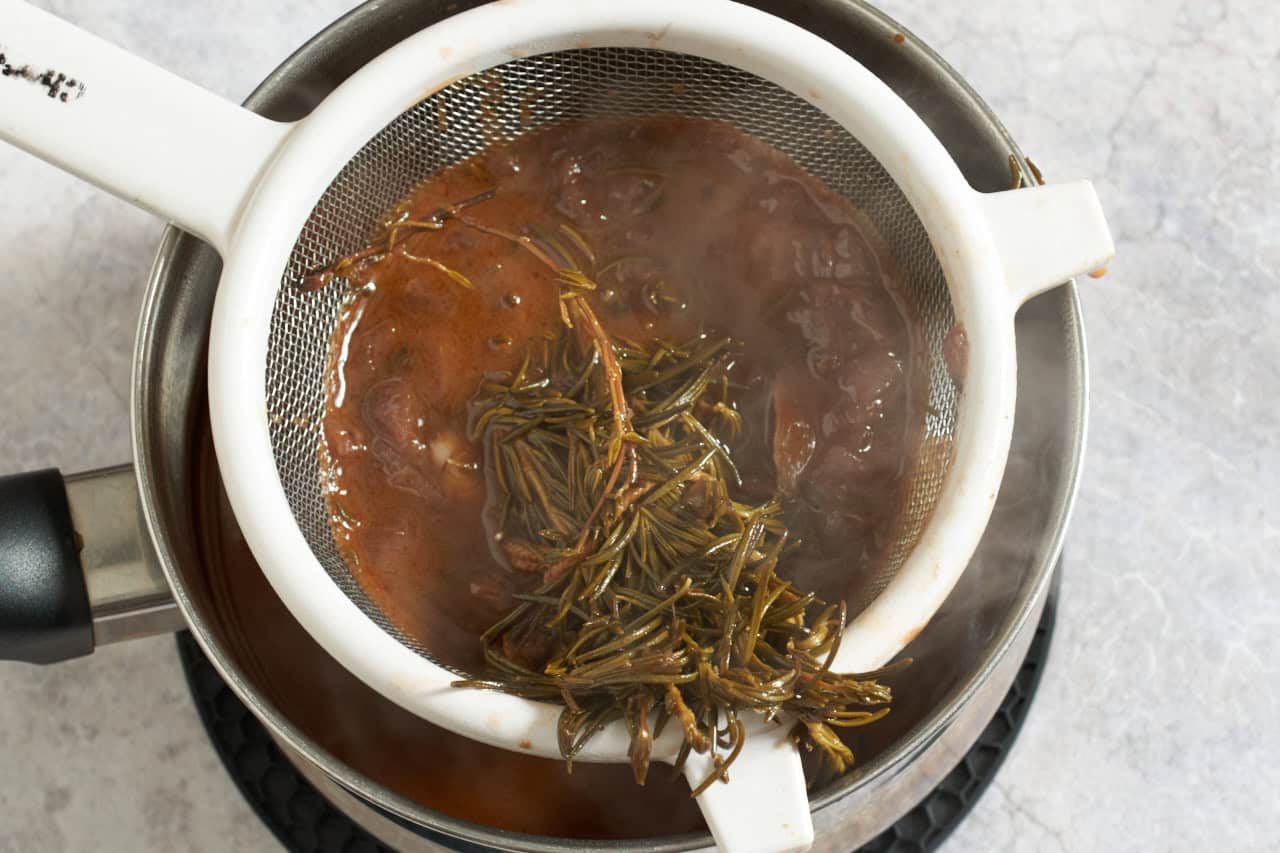
Step 5: Strain and reduce the red wine sauce
Remove the cooked lamb shanks to a serving plate. Place a wire mesh strainer over a medium sauce pan and carefully pour the braising liquid into the pan. Discard the herbs and onions in the strainer.
Bring the liquid to a high simmer over medium heat and reduce by about ⅓. Taste for seasoning and add salt if necessary, then add 1 or more tablespoons of red wine vinegar, according to your liking.
Pour some of the sauce over the lamb shanks on the serving plate, reserve the rest for serving at the table. Top with fresh thyme leaves if desired.
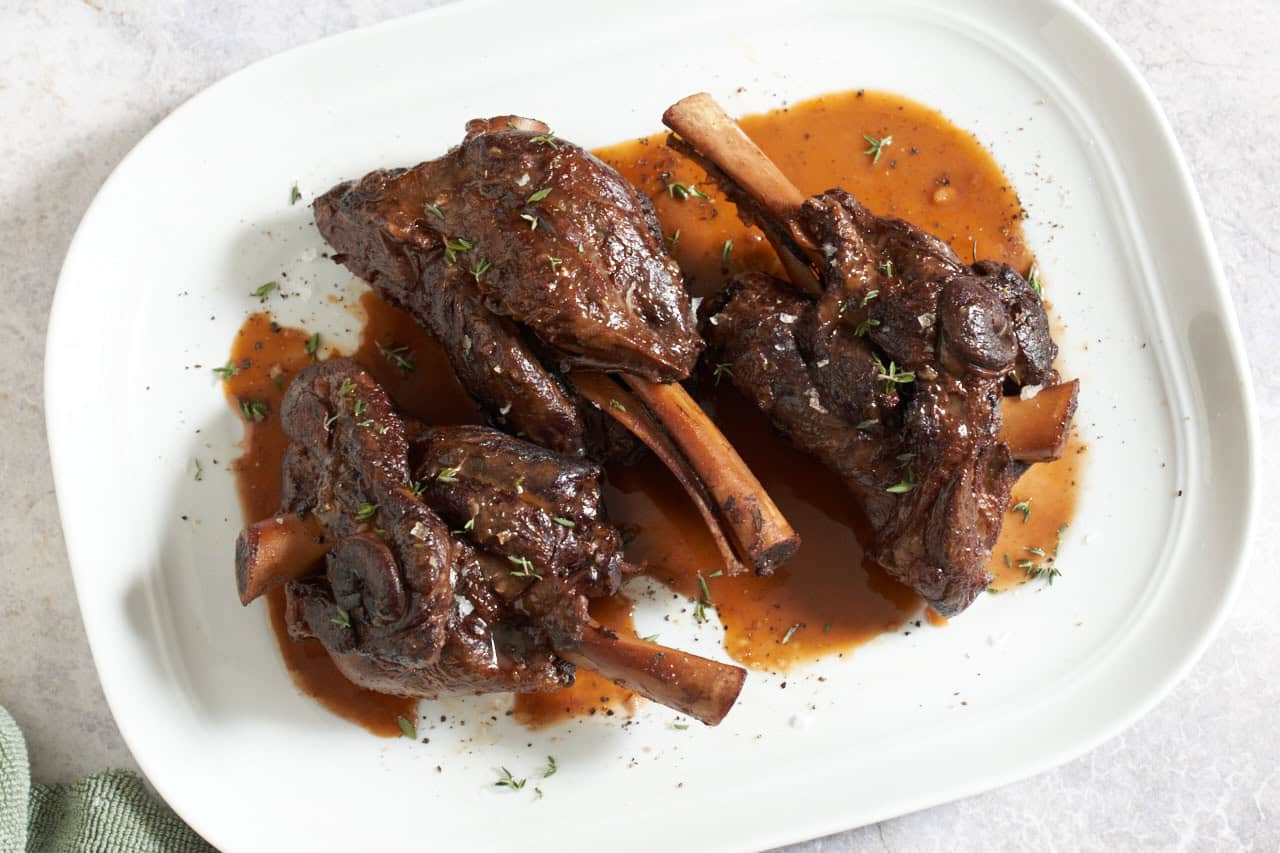
Stovetop instructions
Braising on the stovetop is almost exactly the same as braising in the oven, but differs slightly when you add the wine and stock. You need to get the liquid to a low simmer and maintain it throughout the cooking time.
- Sear the meat and cook aromatics: As directed in oven instructions.
- Add the red wine and stock: Add the red wine to the pot to deglaze it, use a wooden spoon or spatula to scrape up any bits on the bottom of the pan, then add the chicken stock. Return the lamb shanks to the Dutch oven and bring the liquid to a low simmer over medium heat. Make sure the shanks are not completely submerged in the liquid.
- Braise: Cover and reduce heat to medium low. Cook for 2-3 hours, checking occasionally to ensure the liquid is always at a low simmer with a few small bubbles, it should never be boiling.
- Strain and reduce the sauce: As directed in oven instructions.
Slow cooker instructions
Guess what? Slow cooker braised lamb shanks instructions are very similar, too! It's important that the red wine sauce is hot when you add it to the slow cooker to avoid any food safety issues as it heats up.
- Sear the meat and cook aromatics: As directed in oven instructions.
- Add the red wine and stock: Add the red wine to the pot to deglaze it, use a wooden spoon or spatula to scrape up any bits on the bottom of the pan, then add the chicken stock. Bring the liquid to a low simmer over medium heat and let it cook for 3-4 minutes. Place the lamb shanks in the slow cooker, then pour the liquid over them, making sure the meat is not completely submerged.
- Braise: Cover and cook on high for 4 to 5 hours or on low for 6 to 8 hours.
- Strain and reduce the sauce: As directed in oven instructions.
Expert tips
- Don't skip the sear: However you're preparing lamb shanks, always be sure to sear them first! Searing does several things: it gets the cooking process started, it renders some of the fat, and it adds loads of flavor!
- Season lamb shanks and let come to room temp: If you have time, season the shanks and let them sit at room temperature for up to 90 minutes. This will help the seasoning absorb into the meat, and makes for gentler cooking.
- Make sure some meat is above the liquid: About ¼ to ⅓ of each shank should be above the liquid. This is the definition of braising. If the meat is completely submerged, you're stewing not braising, and that creates a much different texture.
- Thicken the red wine sauce: If you'd like a thicker sauce, once strained, combine ½ cup of sauce and 1 tablespoon of corn starch in a small bowl and whisk to incorporate, then stir the mixture back in to the rest of the sauce.
- Don't season the sauce until the end: This is very important! The sauce will take on some of the salt from the seasoning on the lamb, then it will reduce as it braises, and reduce again after you strain it. If you season it beforehand it will be much too salty when it's time to serve it.
Storage and reheating
- Make ahead: Just like any good slow cooked recipe, lamb shanks can be braised in the red wine sauce one day ahead of time.
- To store: Transfer the shanks and sauce to an airtight container and store in the refrigerator for up to 2 days.
- To reheat: Place in a Dutch oven and cover with the lid, then heat it up in a 350 degree oven until warmed through.
What to serve with red wine lamb shanks
You'll want a side dish that is homey and comforting, that complements the French and Italian-inspired flavors, and that's good for soaking up the sauce! Try creamy polenta, roasted garlic mashed potatoes, or asparagus risotto, and don't forget the homemade garlic rolls!
More lamb recipes
- Pan Seared Lamb Chops cook quickly so you can make a fancy dinner in a flash!
- Roast Boneless Leg of Lamb is butterflied and filled with an herb-infused rub, it makes for a stunning Christmas recipe!
- Stuffed Eggplant with Ground Lamb cooks in the oven for hours and fills your house with a delicious aroma!
Braised lamb shanks in red wine is a simple recipe with a lot of flavor!
- Lamb shanks can be braised in the oven, on the stovetop, or in a slow cooker!
- Made with simple, classic ingredients like fresh rosemary and garlic.
- Red wine vinegar in the sauce packs a unique flavor punch!
- The rich, silky red wine sauce soaks up all the flavor of the lamb.
- Make ahead for an elegant dinner.
If you enjoy this recipe, please leave me a 5-star rating ⭐️⭐️⭐️⭐️⭐️ in the recipe card! It really helps others find my content and helps my business grow! Sign up for my newsletter for recipes delivered to your inbox and follow me on Instagram and Pinterest! Thank you!
Recipe

Red Wine Braised Lamb Shanks Recipe
Equipment
Ingredients
- 4 lamb shanks
- 3 tablespoons extra virgin olive oil divided
- 1 yellow onion
- 4 garlic cloves
- 8 sprigs fresh rosemary
- 8 sprigs fresh thyme
- 3 tablespoons tomato paste
- 2 cups light-bodied red wine such as Chianti, Beaujolais, or Tempranillo
- 3 cups chicken stock
- 2 tablespoons red wine vinegar or more if desired
- kosher salt and freshly ground black pepper
Instructions
Oven Instructions
- Preheat the oven to 350 degress F. Place the lamb shanks on a sheet pan and season generously with kosher salt and freshly ground black pepper.
- Place a Dutch oven over medium high heat and add 1 tablespoon of extra virgin olive oil. Working in 2 batches, sear the lamb shanks on all sides until a golden-brown crust begins to form, then set aside on a plate. You'll probably have to use some long-handled tongs to hold them on their sides, or prop them up on the side of the pan get get all the edges.
- While the lamb sears, tie the sprigs of thyme and rosemary together in a bundle with kitchen twine. Peel the garlic cloves and use the side of a good chef's knife to smash them, then set aside. Cut the onion into thick slices. (See note.)
- Once the lamb is browned, reduce the heat to medium and add the remaining olive oil and sliced onions to the Dutch oven with the rendered fat from the shanks. Cook the onions until tender and translucent, about 5-8 minutes. Season with a pinch of kosher salt.
- Add the smashed garlic cloves and the bundle of herbs to the pan and stir for 1-2 minutes until fragrant. Then add the tomato paste, stirring and pressing it into the other ingredients for 1 minute.
- Add the red wine to the pot to deglaze it, use a wooden spoon or spatula to scrape up any bits on the bottom of the pan, then add the chicken stock. Return the lamb shanks and their resting juices to the Dutch oven, making sure the meat is not completely submerged (see note), and cover with the lid. Transfer the lamb shanks to the oven and braise for 2-2 ½ hours, until they are tender and falling off the bone.
- Remove the lamb shanks to a serving plate. Place a wire mesh strainer over a medium sauce pan and carefully pour the sauce into the pan. Discard the herbs and onions in the strainer. Bring the liquid to a high simmer over medium heat and reduce by about ⅓. Pour some of the sauce over the lamb shanks on the serving plate, reserve the rest for serving at the table. Top with fresh thyme leaves if desired.
Slow Cooker Instructions
- Follow all oven instructions through step 5.
- Add the red wine to the pot to deglaze it, use a wooden spoon or spatula to scrape up any bits on the bottom of the pan, then add the chicken stock. Bring the liquid to a low simmer over medium heat and let it cook for 3-4 minutes. Place the lamb shanks and any resting juices in the slow cooker, then pour the liquid over them, the meat should not be fully submerged in the liquid (see note). Cover and cook on high for 4 to 5 hours or on low for 6 to 8 hours.
- Follow oven instructions in step 7 to reduce sauce.
Stovetop Instructions
- Follow all oven instructions through step 5.
- Add the red wine to the pot to deglaze it, use a wooden spoon or spatula to scrape up any bits on the bottom of the pan, then add the chicken stock. Return the lamb shanks and any resting juices to the Dutch oven and bring the liquid to a low simmer over medium heat. Make sure the shanks are not completely submerged in the liquid (see note).
- Cover and reduce heat to medium low. Cook for 2-3 hours, checking occasionally to ensure the liquid is always at a low simmer with a few small bubbles, it should never be boiling.
- Follow oven instructions in step 7 to reduce sauce.
Want to save this recipe?
You'll join hundreds of readers on my email list!
Notes
- Don't stress about chopping the garlic and onions: The onions and garlic are going to be strained out of the red wine sauce before serving, so there's no need to spend a lot of time chopping, slicing or dicing them. Smashing the garlic will ensure it releases all of that flavor, and just make sure you cut the onions about the same size so they cook evenly.
- Don't skip the sear: However you're preparing your lamb shanks, always be sure to sear them first! Searing does several things: it gets the cooking process started, it renders some of the fat, and it adds loads of flavor!
- Season lamb shanks and let come to room temp: If you have time, season the shanks and let them sit at room temperature for up to 90 minutes. This will help the seasoning absorb into the meat, and makes for gentler cooking.
- Make sure some meat is above the liquid: About ¼-1/3 of each shank should be above the liquid. This is the definition of braising. If the meat is completely submerged, you're stewing, and that creates a much different texture.
- Don't season the sauce until the end: This is very important! The sauce will take on some of the salt from the seasoning on the lamb, then it will reduce as it braises, and reduce again after you strain it. If you season it beforehand it will be much too salty when it's time to serve it.
- Thicken the red wine sauce: If you'd like a thicker sauce, once strained, combine ½ cup of sauce and 1 tablespoon of corn starch in a small bowl and whisk to incorporate, then stir the mixture back in to the rest of the sauce.
- Make ahead: Just like any good slow cooked recipe, lamb shanks can be braised in the red wine sauce one day ahead of time.
- To store: Transfer the shanks and sauce to an airtight container and store in the refrigerator for up to 2 days.
- To reheat: Place in a Dutch oven and cover with the lid, then heat it up in a 350 degree oven until warmed through.
Nutrition
Nutrition information is automatically calculated as an estimate. Calorie accuracy is not guaranteed.

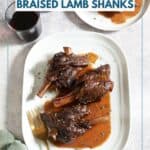
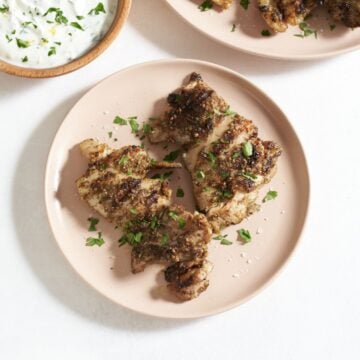

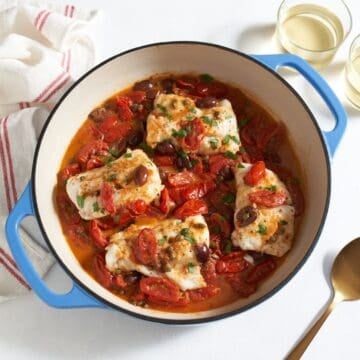
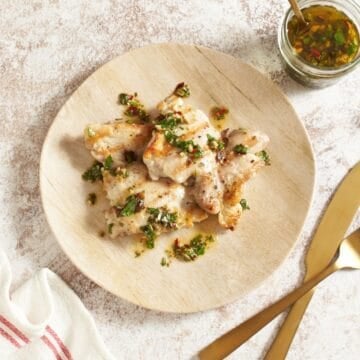
Leave a Reply